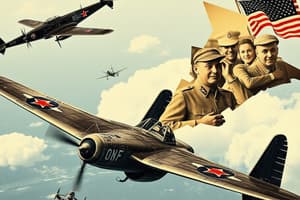Podcast
Questions and Answers
What was the crucial military strategy used by the U.S. to gain control of the Pacific islands during WWII?
What was the crucial military strategy used by the U.S. to gain control of the Pacific islands during WWII?
Island hopping
Who walked on the recaptured Leyte beach in 1944?
Who walked on the recaptured Leyte beach in 1944?
General MacArthur with the President of the Philippines
What naval disaster occurred during the raid with nearly half the men lost on the USS Arizona?
What naval disaster occurred during the raid with nearly half the men lost on the USS Arizona?
Battleship Row
On what date did troops of the 165th infantry advance on Butaritari Beach?
On what date did troops of the 165th infantry advance on Butaritari Beach?
Where did American infantrymen secure an area in March 1944?
Where did American infantrymen secure an area in March 1944?
What was happening overhead as U.S. troops were bound for the beaches of Leyte island in October 1944?
What was happening overhead as U.S. troops were bound for the beaches of Leyte island in October 1944?
What tragic event occurred in Guam in 1944 involving Japanese soldiers?
What tragic event occurred in Guam in 1944 involving Japanese soldiers?
What was the percentage of Japanese planes lost on December 7th?
What was the percentage of Japanese planes lost on December 7th?
What were two major battles that involved U.S. warships and airplanes destroying Japanese fleets?
What were two major battles that involved U.S. warships and airplanes destroying Japanese fleets?
What success did the U.S. achieve in June 1944 at Cape Sansapor?
What success did the U.S. achieve in June 1944 at Cape Sansapor?
What crucial ship was destroyed after the USS Yorktown was abandoned on June 4, 1942?
What crucial ship was destroyed after the USS Yorktown was abandoned on June 4, 1942?
What campaign were infantry troops seen boarding landing barges in relation to?
What campaign were infantry troops seen boarding landing barges in relation to?
After three days of fighting, what did the Marine tank crew do?
After three days of fighting, what did the Marine tank crew do?
What happened on January 1943 when two US Marines inspected a Japanese dugout?
What happened on January 1943 when two US Marines inspected a Japanese dugout?
What major conflict occurred when landing on Saipan, Mariana Islands in June 1944?
What major conflict occurred when landing on Saipan, Mariana Islands in June 1944?
What iconic photo represented hope to the American people after the battle on Iwo Jima?
What iconic photo represented hope to the American people after the battle on Iwo Jima?
Flashcards are hidden until you start studying
Study Notes
Island Hopping Strategy
- Island hopping was a key military tactic used by the U.S. to capture Pacific islands held by the Japanese during WWII.
- This strategy allowed U.S. forces to gain ground while bypassing heavily fortified islands, ultimately facilitating a path to Japan.
Key Figures and Events
- General Douglas MacArthur famously walked on Leyte Beach in the Philippines in 1944, symbolizing the recapture of the territory.
- The USS Arizona suffered significant casualties during the Pearl Harbor attack, losing nearly half its crew within the initial raid.
Major Battles and Campaigns
- The Battle of Coral Sea and Battle of Midway led to the destruction of two Japanese fleets, marking a turning point in the Pacific Theater.
- The invasion of Butaritari Beach, Makin Atoll on November 20, 1943, involved the 165th Infantry and resulted in the capture of Gilbert Islands from Japanese forces.
Frontline Engagements
- On Bougainville, American infantrymen secured territory in March 1944 after a night infiltration by Japanese troops.
- During the Leyte invasion in October 1944, U.S. troops faced aerial battles above their landing crafts, highlighting the multi-faceted nature of warfare.
Casualty and Warfare Insights
- Numerous Japanese soldiers were killed during a banzai charge in Guam, indicating fierce combat conditions as U.S. forces pushed further into enemy territory.
- Approximately 10% of Japanese planes were lost during the initial attack on December 7th, 1941, which set the stage for U.S. military engagement in the Pacific.
Progress and Struggles
- By June 1944, heavily packed transport ships were crucial for the successful invasion of Cape Sansapor, New Guinea, showcasing U.S. logistical capabilities.
- USS Yorktown, a pivotal naval vessel, was abandoned on June 4, 1942, after being critically damaged during battle.
Tactical Situations and Enemy Engagements
- Continuous boarding of landing barges exemplified U.S. forces' commitment during the Bougainville Campaign.
- Following three days of intense fighting, a Marine tank crew regrouped to maintain their equipment after destroying numerous Japanese fortifications.
Final Stages of Conflict
- In January 1943, U.S. Marines inspected Japanese dugouts during an advance, highlighting the aggressive tactics employed by American forces.
- The June 1944 landing at Saipan exemplified the challenges faced by U.S. Marines, including ambush tactics from Japanese enemy forces who often vanished during the day.
Iconic Moments and Symbolism
- A photograph taken in February 1945 of Marines raising the flag on Iwo Jima became a powerful symbol of hope for the American people following a month of intense fighting.
Studying That Suits You
Use AI to generate personalized quizzes and flashcards to suit your learning preferences.




